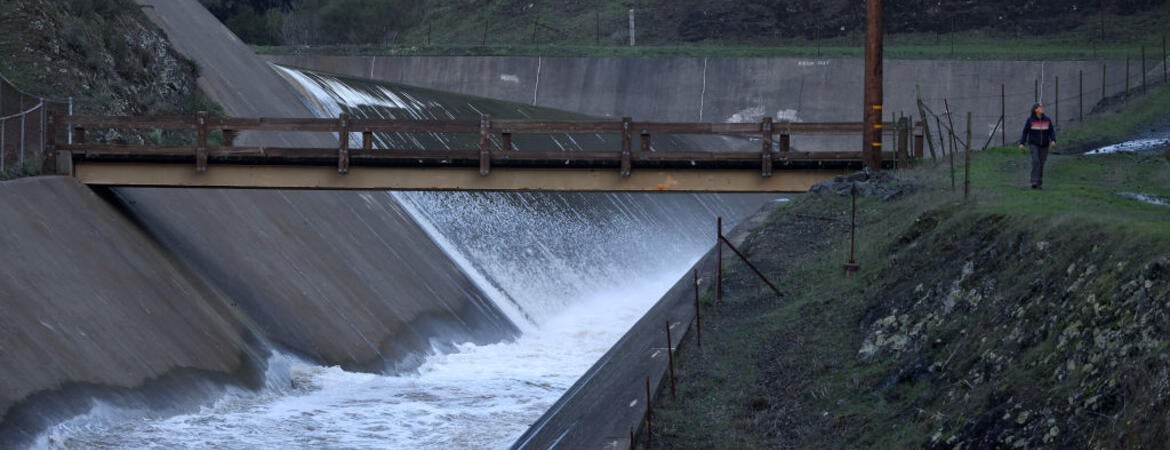
After several weeks of rain, Southern California remains under advisories for flooding, high winds, and high surf. Early this week, 90% of California was under a flood watch. L.A. County — which has received 2 to 6 inches of rain along the coast and in coastal valleys and about 8 inches in the mountains — could see an additional .5 to 1.5 inches, with more expected at higher elevations, meteorologists say. Here, Kurt Schwabe, the associate dean of the School of Public Policy and a professor of environmental economics and policy, addresses the infrastructure deficits this spate of rain had laid bare.
Q: Can the California stormwater drainage and flooding infrastructure handle this level of rainfall?
Schwabe: Based on what we're seeing and observing in terms of the destruction these past few storms have created, it's clear that our stormwater and flooding infrastructure is falling short of what we should expect given California is the seventh largest economy in the world.
But, the "losses" are significantly more than this when one considers how much of this water we are not storing or capturing to help refill aquifers and reservoirs. To deal with the increased aridity and fewer, albeit more intense, precipitation events that are coming to characterize our climate more and more regularly, we need to do a better job at capturing and storing the water from these events. Failure to do so will lead to increased water scarcity and, consequently, greater difficulty in meeting water demands for agriculture and food production, the environment, and health and human services.
Q: Should we consider this level of winter rainfall an anomaly, or might it be California’s “new normal”?
Schwabe: What we are observing right now seems to be consistent with the predictions by scientists who specialize in modeling atmospheric dynamics and climate science, i.e., more frequent and intense droughts along with more intense rainfall events and the potentially greater chance of more wild swings between the two than what would have been expected in the past, a characteristic that has garnered the moniker, "climate whiplash."
Q: Like wildfire, we have historically viewed flooding as something to be avoided. Is that wrongminded thinking in California?
Schwabe: Flooding provides both benefits and costs. What occupies most of the news cycle today is the costs and damages from large-scale flooding events, including damages and losses to property and, tragically, damages to and losses of human life. Clearly, we want to continue to invest in smart strategies to reduce those sorts of damages and losses.
But, historically, the benefits of flooding have been known to farmers in terms of replenishing soils. And science has come to recognize the benefits of flooding in terms of restoring latent ecosystem services. So, we want to curtail and mitigate the impacts of some flooding events, but we benefit and thus would likely want to see an increase in the frequency of some other flooding events.
Q: What’s the need for and likelihood of “managed retreat” in California, in which structures and communities are moved to allow for more flooding? What’s working against it?
Schwabe: I think of "managed retreat" like health care, i.e., being proactive in terms of taking care of one's health is much less expensive than being reactive. It will be much less costly to consider and identify where the vulnerable spots are now and will be and start to invest in both mitigation and adaptation. In some cases, the private market will motivate this, perhaps through increases in insurance rates to live in such zones. But there is a role for government, too, in both helping to create and regulate markets so that efficient, equitable, and sustainable outcomes can arise,
Q: Increasingly, Californians are wary of buying homes in some parts of the state because of wildfire risk. Are there areas of California (Montecito may be an example) that will become “unlivable” due to the potential for flooding and mudslides?
Schwabe: I believe so. The degree to which areas will become unlivable will depend on the level of flood risk each area poses, where "risk" if a function of three interacting factors. First, there is the "hazard", which accounts for the probability and magnitude of the actual event. Second, it will depend on the exposure of the residents to the risk, which accounts for the economic value of the assets that would be subjected to the risk. Finally, it will be dependent on the vulnerability of the assets, which accounts for the potential for economic (a broad definition that includes loss of human life) loss from the event. As the risks increase, I would suspect it might be difficult to get insurance for locating in such areas (or insurance that isn't extremely expensive) and that in and of itself might drive people out of the market in those areas if natural risks do not.
Q: In August, Gov. Newsom released a plan, “California’s Water Supply Strategy: Adapting to a Hotter, Drier Future.” The three-year plan, already underway, will invest $8.7 billion to, in part, address “California’s water future by reimagining the way we source, store and deliver water statewide for future generations.” The plan is motivated by optimizing the water supply, not stormwater infrastructure. In the interest of capturing more water for use, the plan includes expanding reservoir capacity, rehabbing dams, building stormwater “diversion” infrastructure, more places to park runoff, “groundwater recharge,” and the ability to move the water to where it is needed to take advantage of fast-moving storms. Does any of this help address periods of sustained rainfall?
Schwabe: Yes, it does help address the increased risks of flooding, but not completely since, as you point out, it focuses on water supply and not flood risk. But, the two have a lot in common.



